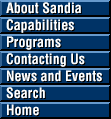FOR IMMEDIATE RELEASE
July 19, 2001
Tool against terrorism and other disasters
Sandia to release first risk-based approach to building management software for use by GSA
ALBUQUERQUE, N.M. — RAMPART, software developed by Sandia National Laboratories that is the first risk-based approach to building management, may soon help the General Services Administration (GSA) assess the risks of terrorism, natural disasters and crime to the nearly 8,000 federal buildings it manages nationwide.
GSA turned to Sandia, a Department of Energy national laboratory, in mid-1998 following the Oklahoma City bombing and several devastating natural disasters to create a screening-level software program that could analyze the risk of potential threats to buildings. After nearly three years of development, RAMPART, for Risk Assessment Method — Property Analysis and Ranking Tool, is ready.
“Traditionally buildings have been constructed to code, which pays attention to disasters that have already happened,” says Regina Hunter, RAMPART technical lead. “RAMPART looks to the future probability of events occurring and what there is to lose if those events take place.”
The software development is part of Sandia’s Architectural Surety® program, which uses technology to make homes, shopping malls, offices, public buildings, and infrastructures safer in a natural disaster or terrorist attack.
While the initial RAMPART software was developed specifically to analyze risks for GSA-managed buildings, it could easily be adopted for other critical facilities such as embassies, school systems, and large municipalities.
“We think RAMPART could have wide application for other government agencies and in the private sector,” says Rudy Matalucci, RAMPART project manager.
Starting this month the RAMPART team is taking the software on the road, giving formal training sessions at the 10 GSA regional offices. The first was July 10 in Denver, to be followed with a session in Fort Worth. Training at the remaining regional offices is planned through the end of September.
In developing RAMPART, the Sandia team built equations for threatening events — natural hazards including hurricanes, tornadoes, earthquakes, winter storms, and floods as well as crime and terrorism — and information on the building’s location, construction type, numbers of people housed, types of activities underway, and numerous other factors. The equations could then determine the risk for an event at a particular building.
For example, Hunter says, take an empty warehouse slated for demolition in an area highly prone to hurricanes. While the potential for a hurricane is large, the consequences are unimportant, and therefore risk turns out to be very low.
However, if it were a large federal building that housed thousands of people, including several hundred from “lightning rod” agencies like the Federal Bureau of Investigation or the Bureau of Alcohol, Tobacco, and Firearms, and was in the same hurricane-prone location, the risk would be much higher, she says.
RAMPART consists of a user interface, a threatening-events database, and an expert system of rules that embody the GSA’s knowledge about buildings and tenants and Sandia’s knowledge of risk analysis. Using the software, it will take a GSA staff member less than two hours to complete a building risk analysis.
“All users have to do is point and click their way through the assessment,” Hunter says. “They will be asked basic questions about the building — location, construction, security monitoring, etc. — and the computer program will do the rest.”
She adds that the “interface does not request any information that a GSA property manager can’t reasonably be expected to have access to.” For example, the user is not asked to evaluate risk or to provide data on the probability of natural hazards in the area. RAMPART contains this information in its database.
After completing a building assessment, users learn whether the building is considered to be a very high, high, medium, low, or negligible risk. They receive additional information about the risk factors in the form of a bar chart that shows the risk for the consequences analyzed for each hazard. The graphical presentation allows the user to see and distinguish at a glance both the infrequent high risks and the frequent low risks that the building presents.
The GSA regional offices were involved in the software creation. Hunter met with five of the ten regional offices at least once and with the field office in Albuquerque three or four times to query them on their needs and obtain input on the software as it was developed.
RAMPART will continue to change as the GSA regional offices begin using the software. The regional offices will help Sandia improve the software.
Sandia is a multiprogram laboratory operated by Sandia Corporation, a Lockheed Martin Company, for the United States Department of Energy under contract DE-AC04-94AL85000. With main facilities in Albuquerque, N.M., and Livermore, Calif., Sandia has major research and development responsibilities in national security, energy and environmental technologies, and economic competitiveness.
Sandia media contact:
Chris Burroughs, coburro@sandia.gov, (505) 844-0948
Sandia technical contact: Susan D. Carson,
sdcarso@sandia.gov (505) 845-8713 |
